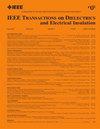Mechanisms for DC Breakdown Strength Degradation in Epoxy/Glass Fiber Composites Under Long-Term Aging
IF 3.1
3区 工程技术
Q2 ENGINEERING, ELECTRICAL & ELECTRONIC
IEEE Transactions on Dielectrics and Electrical Insulation
Pub Date : 2025-02-19
DOI:10.1109/TDEI.2025.3543794
引用次数: 0
Abstract
In modern power systems, the proportion of epoxy/glass fiber (EP/GF) composites that served as the primary insulation composites in electrical equipment is steadily increasing. These devices suffer long-term electrical, thermal, and vibrational stresses during operation, leading to degradation and finally insulation failures. However, the underlying electrical-thermal–vibrational aging mechanisms of the dc breakdown performance of EP/GF composites remain unclear. In this work, combined electrical-thermal–vibrational aging experiments (1080 h) were performed on the prepared EP/GF composites. Infrared spectrum, dielectric spectrum, surface potential decay (SPD), and breakdown tests were used to characterize the functional groups, side-chain dynamics, trap levels, and dc breakdown strength of aged EP/GF composites. The research indicates that after long-term aging, the dc breakdown strength of EP/GF composites first increases by 5.8% at 72 h and then decreases by 20.6% at 1080 h. The aging of EP/GF composites is divided into recrosslinking and degradation stages. The recrosslinking stage enhances the dc breakdown strength of the EP/GF composites by reducing free volume before 72 h. While in the degradation stage, chain breaking and oxidation of epoxy chains steadily occur, introducing abundant short chains and polar groups (carbonyl and ester groups), improving free volume fraction, and accelerating chains’ dynamic. The improved free volume fraction accelerates electron avalanche in the electric field, stimulating charges to escape from traps and causing dc breakdown strength to considerably decrease during 72–1080 h.环氧/玻璃纤维复合材料长期老化下直流击穿强度下降的机理
在现代电力系统中,环氧/玻璃纤维(EP/GF)复合材料作为主要绝缘材料在电气设备中的比例正在稳步增加。这些设备在运行过程中承受长期的电、热、振动应力,导致性能退化,最终导致绝缘失效。然而,EP/GF复合材料直流击穿性能的电-热-振动老化机制尚不清楚。对制备的EP/GF复合材料进行了1080 h的电-热-振动复合时效实验。利用红外光谱、介电光谱、表面电位衰减(SPD)和击穿测试表征老化EP/GF复合材料的官能团、侧链动力学、陷阱能级和直流击穿强度。研究表明,EP/GF复合材料的直流击穿强度在72 h时先提高5.8%,在1080 h时下降20.6%,EP/GF复合材料的老化过程分为重交联和降解两个阶段。重交联阶段通过减少72 h前的自由体积,提高了EP/GF复合材料的直流击穿强度。降解阶段,环氧链的断链和氧化稳定发生,引入了大量的短链和极性基团(羰基和酯基),提高了自由体积分数,加速了链的动态变化。自由体积分数的提高加速了电场中的电子雪崩,刺激电荷从陷阱中逸出,导致直流击穿强度在72 ~ 1080 h内显著降低。
本文章由计算机程序翻译,如有差异,请以英文原文为准。
求助全文
约1分钟内获得全文
求助全文
来源期刊
CiteScore
6.00
自引率
22.60%
发文量
309
审稿时长
5.2 months
期刊介绍:
Topics that are concerned with dielectric phenomena and measurements, with development and characterization of gaseous, vacuum, liquid and solid electrical insulating materials and systems; and with utilization of these materials in circuits and systems under condition of use.

 求助内容:
求助内容: 应助结果提醒方式:
应助结果提醒方式:


